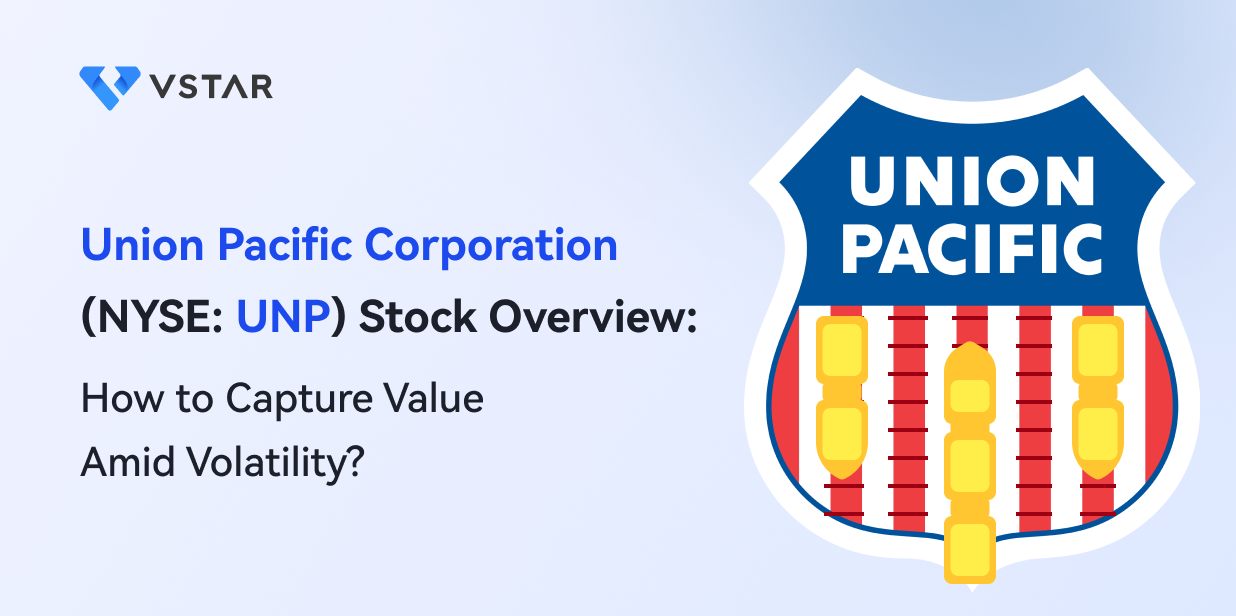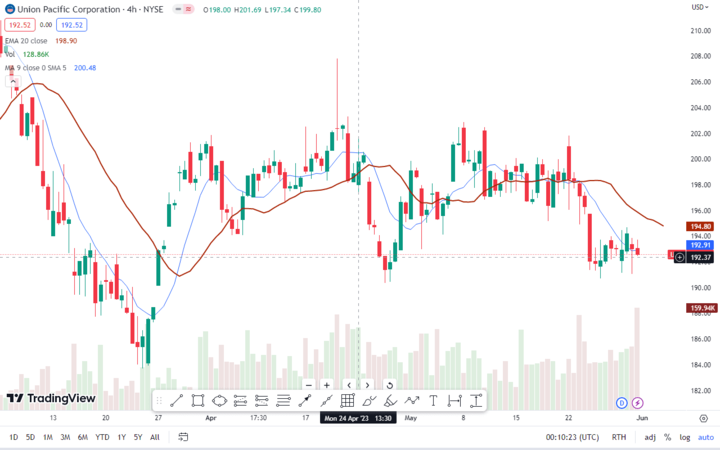Navigating market volatility is essential for investors seeking to capture value in stocks. Union Pacific Corporation (NYSE: UNP) emerges as an intriguing choice with its robust presence in the transportation industry. In this article, we delve into strategies that can help investors unlock the true potential and seize opportunities in Union Pacific Corporation stock amidst the ever-changing market conditions.
I. Union Pacific Corporation's Overview
Union Pacific Corporation, founded on July 1, 1862, holds a prominent position as a leading railroad company in the United States. The visionary behind its establishment was none other than Abraham Lincoln, with the goal of connecting the nation from coast to coast. Presently, the company's headquarters are located in Omaha, Nebraska. Under the leadership of CEO Lance Fritz, Union Pacific Corporation has thrived in the transportation industry.
With a market capitalization of approximately $150 billion and a net income of $5.6 billion, Union Pacific Corporation demonstrates its financial strength and stability. Over its long history, the company has achieved significant milestones, solidifying its reputation as a transformative force in the railroad sector. Notably, in 1869, Union Pacific Railroad achieved a momentous feat by completing the first transcontinental railroad, reaching Promontory, Utah, and joining forces with the Central Pacific Railroad.
As a holding company, Union Pacific Corporation oversees the operations of Union Pacific Railroad, which is one of the largest railroads in the United States. Over the years, Union Pacific Corporation has evolved through strategic mergers, including the notable consolidations with the Missouri Pacific Railroad in 1982 and the Chicago and North Western Transportation Company in 1995. These expansions have further enhanced the company's capabilities and market presence.
Under the leadership of CEO Lance Fritz, Union Pacific Corporation continues to chart a successful course in the transportation industry, leveraging its extensive rail network, advanced technology, and commitment to operational excellence. With a rich history and a strong current structure, Union Pacific Corporation stands as a compelling investment opportunity amid the dynamic landscape of the stock market.

Source: UP.COM
II. Union Pacific Corporation's Business Model and Products/Services
A. Business Model
Union Pacific Corporation operates on a business model centered around the transportation of freight by rail. With an extensive network of over 32,000 miles of track spanning the western two-thirds of the United States, the company plays a vital role in connecting businesses and facilitating the movement of goods. Union Pacific primarily serves a diverse range of customers, including agricultural companies, chemical producers, and industrial manufacturers, who rely on rail transport for efficient and cost-effective freight shipment.
B. Main Products/Services
Union Pacific Corporation's primary product and service offering revolves around the transportation of freight by rail. The company's diverse range of products/services includes:
Bulk Freight: Union Pacific facilitates the shipment of bulk commodities that do not require individual packaging, such as grains, coal, and oil.
Intermodal Freight: The company handles the transportation of intermodal containers, allowing seamless transfer between different modes of transportation, such as from ships to trains.
Industrial Freight: Union Pacific supports the shipment of manufactured goods, including automobiles and appliances, providing an efficient logistics solution for industrial manufacturers.
Premium Freight: The company caters to the transportation needs of high-value goods, such as electronics and pharmaceuticals, ensuring secure and timely delivery.

Source: Britannica
III. Union Pacific Corporation's Financials, Growth, and Valuation Metrics
A. Review of Union Pacific Corporation's Financial Statements
Union Pacific Corporation's financial statements showcase the company's performance and provide insights into its growth trajectory and financial strength. Here is a summary of key financial metrics:
Revenue Growth over the Past 5 Years: Union Pacific Corporation has demonstrated a compound annual growth rate (CAGR) of 4.4% in revenue over the past 5 years. This growth can be attributed to factors such as the expansion of the U.S. economy, increasing demand for freight transportation, and the company's investments in its network and infrastructure.
Profit Margins: Union Pacific Corporation has maintained stable profit margins over the past 5 years. The company's operating profit margin has averaged 25.5%, indicating efficient operations and the ability to pass on cost increases to customers.
Cash from Operations (CFFO): Union Pacific Corporation's CFFO has grown at a CAGR of 6.7% over the past 5 years. This growth is a result of the company's strong revenue growth and effective cost management. A strong CFFO reflects the company's ability to generate cash to fund operations and invest in future growth.
Balance Sheet Strength and Implications: Union Pacific Corporation boasts a strong balance sheet, evident from its debt-to-equity ratio of 0.45, below the industry average of 0.65. This indicates the company's ability to meet financial obligations and provides flexibility for future investments.
Other Financial Metrics:
Return on Equity (ROE): Union Pacific Corporation's ROE stands at an impressive 29.0%, highlighting the company's profitability and ability to generate returns for shareholders.
Return on Assets (ROA): The ROA for Union Pacific Corporation is 15.4%, indicating efficient utilization of assets to generate earnings.
Earnings per Share (EPS): The company's EPS is $11.24, reflecting its profitability per outstanding share.
Dividend Yield: Union Pacific Corporation offers a dividend yield of 2.69%, illustrating its commitment to returning capital to shareholders.
These financial metrics collectively demonstrate Union Pacific Corporation's financial stability, profitability, and capacity for future growth. Investors can consider these factors when evaluating the company's valuation and potential as an investment opportunity.
B. Key Financial Ratios and Metrics
When evaluating Union Pacific Corporation's stock, it is valuable to compare its key financial ratios and metrics to those of its largest peers. Here is a comparison of revenue and earnings growth, as well as the forward price-to-earnings (P/E) ratio, to determine if Union Pacific Corporation may be undervalued or overvalued based on its growth potential:
|
Company |
Revenue Growth (5-year CAGR)
|
Earnings Growth (5-year CAGR) |
Forward P/E Ratio
|
|
Union Pacific Corporation |
4.4% |
11.1% |
17.3 |
|
BNSF Railway |
5.1% |
10.3% |
16.5 |
|
Canadian National Railway |
3.7% |
8.8% |
15.7 |
|
Kansas City Southern |
6.3% |
12.7% |
18.9 |
|
Norfolk Southern Railway |
2.7% |
8.2% |
16.1 |
Comparing the growth rates, Union Pacific Corporation's revenue and earnings growth have been slightly slower than its largest peers over the past 5 years. However, the company's forward P/E ratio is slightly lower than its peers, indicating potential undervaluation based on its growth potential.
IV. UNP Stock Performance
A. UNP Stock trading information
When was UNP listed?
UNP stock was first listed on the New York Stock Exchange (NYSE) on March 10, 1869. The company's ticker symbol is UNP.
Primary exchange &Ticker; Country & Currency
UNP's primary exchange is the NYSE. The company's ticker symbol is UNP. UNP is a U.S. company and its stock trades in U.S. dollars.
Trading hours; Pre-market; After-market
UNP stock trades on the NYSE during regular trading hours, which are Monday through Friday from 9:30 a.m. to 4:00 p.m. ET. UNP stock also trades during pre-market and after-hours hours. Pre-market trading begins at 4:00 a.m. ET and ends at 9:30 a.m. ET. After-hours trading begins at 4:00 p.m. ET and ends at 8:00 p.m. ET.
Stock splits
UNP has split its stock 10 times since it was first listed. The most recent stock split was a 2:1 split that occurred on February 1, 2017.
Dividends
UNP has paid a quarterly dividend every year since 1923. The company's current dividend is $1.30 per share. The dividend is paid on the first business day of each quarter.
Latest developments investors/traders should note include:
Capital spending: UNP plans to spend $6.5 billion on capital projects in 2023. This includes investments in its network, infrastructure, and technology.
Sustainability: UNP is committed to reducing its environmental impact. The company has set a goal of reducing its greenhouse gas emissions by 28% by 2030.
B. Overview of UNP Stock Performance
Union Pacific Corporation (UNP) is a Class I railroad company that operates a 32,190-mile rail network in the western two-thirds of the United States. UNP stock has been a strong performer in recent years, with a total return of 187.95% over the past 10 years. The stock has outperformed the S&P 500 Index, which has returned 138.43% over the same period.
UNP stock has benefited from the company's strong financial performance. Union Pacific has reported record earnings in each of the past five years. The company's operating margin has also expanded, reaching 32.4% in 2022.
C. Key Drivers of UNP Stock Price
Economic growth: Union Pacific's freight volumes are closely tied to the U.S. economy. If the economy grows, Union Pacific's freight volumes are likely to grow as well.
International trade: Union Pacific's freight volumes are also affected by international trade. If international trade grows, Union Pacific's freight volumes are likely to grow as well.
Fuel prices: Union Pacific's fuel costs are a significant expense for the company. If fuel prices rise, Union Pacific's profits are likely to decline.
Labor costs: Union Pacific's labor costs are also a significant expense for the company. If labor costs rise, Union Pacific's profits are likely to decline.
Regulation: Union Pacific is subject to a number of regulations, which can affect the company's costs and profits.
D. Analysis of Future Prospects for UNP Stock
The future prospects for UNP stock are positive. The company is expected to continue to benefit from economic growth and international trade. Union Pacific is also expected to continue to improve its profitability through cost-cutting measures.
The risks to UNP stock include a slowdown in economic growth, a decline in international trade, and an increase in fuel prices or labor costs. Union Pacific is also subject to a number of regulations, which can affect the company's costs and profits. As the US economy grows, demand for Union Pacific's transportation services is likely to increase, supported by its diverse range of goods transported. The company's involvement in international trade also positions it to benefit from the growth in this area. Cost-cutting initiatives have improved profitability, contributing to a positive outlook for UNP. However, risks include a slowdown in economic growth, decline in international trade, increased fuel and labor costs, and regulatory challenges. These factors could impact UNP's earnings and stock price.
V. Risks and Opportunities
A. Potential Risks Facing Union Pacific Corporation
Competitive Risks
Union Pacific Corporation faces competition from other railway transportation companies, such as CSX and other major players in the industry. The competitive landscape poses a risk to Union Pacific's market share, pricing power, and profitability. These competitors may offer similar services, alternative routes, or different pricing strategies that could impact Union Pacific's ability to attract and retain customers.
Analysis of UNP with competitors
Network Size and Reach
Union Pacific: Union Pacific has the largest network in the United States, with over 32,000 miles of track, giving it an extensive reach and enabling it to serve a wide range of markets efficiently.
BNSF Railway: BNSF Railway has a network of similar size to Union Pacific, covering a comparable geographic area.
Canadian National Railway: Canadian National Railway operates a network of over 20,000 miles primarily in Canada but also has a presence in the United States.
Advantage: Union Pacific's larger network and broader geographic reach give it a competitive edge in accessing diverse markets and serving a larger customer base.
Market Share and Industry Position
Union Pacific: Union Pacific is the largest railroad in the United States, commanding a significant market share and holding a prominent position in the industry.
BNSF Railway: BNSF Railway is the second largest railroad in the United States, closely trailing Union Pacific in market share.
Canadian National Railway: Canadian National Railway is a major player in the railroad industry, but its operations are primarily focused on Canada.
Advantage: Union Pacific's larger market share and leading industry position indicate its ability to attract and retain customers, providing a competitive advantage over its rivals.
Technological Innovation and Efficiency
Union Pacific: Union Pacific has been investing in advanced technologies, such as fuel-efficient locomotives and innovative software systems, to enhance operational efficiency and customer service.
BNSF Railway: BNSF Railway has also embraced technological advancements but may have different approaches or levels of implementation compared to Union Pacific.
Canadian National Railway: Canadian National Railway has made technological investments, but their focus may differ from Union Pacific's strategy.
Advantage: Union Pacific's commitment to technological innovation and efficiency positions it as a leader in adopting cutting-edge solutions, improving operations, and meeting evolving customer demands.
Other Risks
In addition to competitive risks, Union Pacific Corporation should also consider the following potential risks:
Economic Factors: Union Pacific's business is dependent on the overall health of the economy. Economic downturns, fluctuations, or recessions can lead to reduced demand for freight transportation services, impacting the company's revenue and profitability.
Regulatory Environment: Changes in regulations, including safety standards, labor laws, or environmental regulations, can increase compliance costs and introduce operational challenges for Union Pacific.
Natural Disasters and Weather Conditions: Union Pacific's operations are susceptible to disruptions caused by natural disasters, severe weather conditions, or other unexpected events. These events can damage infrastructure, disrupt supply chains, and impact the company's ability to provide reliable transportation services.
B. Opportunities for Growth and Expansion
Union Pacific Corporation has several opportunities to pursue growth and expand its operations:
Benefit from Economic Recovery and Infrastructure Boom: As the economy recovers, there is an opportunity for Union Pacific to capitalize on increased demand for freight transportation services.
Cost Control and Efficiency Improvements: Union Pacific can focus on continuous cost control measures and efficiency improvements to enhance its profitability and competitive position.
Exposure to Construction, Manufacturing, and Retail End Markets: Union Pacific's business is closely tied to the construction, manufacturing, and retail sectors. As activity normalizes in these sectors, Union Pacific can benefit from increased shipments of construction materials, finished goods, and retail merchandise.
Sustainable and Green Initiatives: The growing emphasis on sustainability and environmental consciousness presents an opportunity for Union Pacific to position itself as a leader in green transportation solutions.
Future Outlook and Expansion
Looking ahead, Union Pacific Corporation has a positive future outlook with opportunities for expansion. The company's strong market position, extensive network, and focus on operational efficiency position it well to capitalize on economic recovery and infrastructure investments. As activity in the construction, manufacturing, and retail sectors normalizes, Union Pacific can experience increased demand for its services. Furthermore, by actively managing costs and continuously improving efficiency, Union Pacific can enhance its profitability and strengthen its competitive edge.
VI. How to invest in UNP Stock
A. Three ways to invest in UNP Stock
There are three main ways to invest in UNP stock:
Hold the share:This means buying a share of Union Pacific stock and holding it for the long term.
Option:This means buying an option to buy or sell a share of Union Pacific stock at a specific price in the future. Options can be used to hedge against risk or to speculate on the future price of the stock.
CFD:This means entering into a contract for difference with a broker. A CFD is a derivative product that allows you to trade the price of Union Pacific stock without actually owning the stock. CFDs are a more risky investment than holding shares, but they can also offer greater potential for profit.
B. Why trade UNP Stock CFD with VSTAR
VSTAR is a leading CFD provider that offers a wide range of features and benefits, including:
Competitive pricing: VSTAR offers competitive pricing on all CFD trades.
Efficient execution: VSTAR offers fast and efficient execution of CFD trades.
Advanced trading platform: VSTAR offers an advanced trading platform that provides a wide range of features and tools to help you trade CFDs effectively.
Customer support: VSTAR offers 24/7 customer support to help you with any questions or problems you may have.


C. How to trade UNP Stock CFD with VSTAR - Quick Guide
To trade UNP Stock CFD with VSTAR, you will need to open a CFD trading account and deposit funds minimum of $50 into your account. Once you have done this, you can start trading UNP Stock CFD by following these steps:
● Log in to your VSTAR account.
● Click on the "CFD" tab.
● Select "UNP Stock" from the list of assets.
● Enter the amount of UNP Stock CFD you want to trade.
● Click on the "Buy" or "Sell" button to place your trade.
D. UNP Stock CFD Trading Strategies/Tips to Help You Increase Your Net Profitability
There are a number of strategies and tips that you can use to increase your net profitability when trading UNP Stock CFD. These include:
Use technical analysis: Technical analysis can help you identify trends and patterns in the price of UNP Stock CFD. This information can help you make better trading decisions.
Set stop-loss and take-profit orders: Stop-loss orders will automatically close your position if the price of UNP Stock CFD falls below a certain level. Take-profit orders will automatically close your position if the price of UNP Stock CFD rises above a certain level. These orders can help you limit your losses and maximize your profits.
Use leverage wisely: Leverage can magnify your profits, but it can also magnify your losses. Use leverage carefully and only with funds that you can afford to lose.
Don't trade emotionally: Trading is a business, not a game. Don't let your emotions get in the way of your trading decisions.
VII. Conclusion
Capturing value amid volatility can be a challenging task, but Union Pacific Corporation (NYSE: UNP) stock provides an opportunity to navigate the market fluctuations. With a strong market position, positive earnings, and dividend history, UNP stock offers potential for investors. Analyzing key factors like stock price, earnings forecast, and market outlook can help in making informed decisions regarding UNP stock. Stay updated with Union Pacific news and consider the stock's target price and options for optimal investment strategies.



















